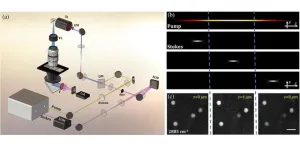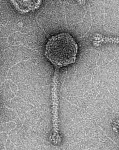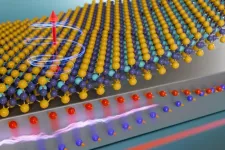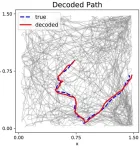(Press-News.org) Understanding complex biological and biomedical systems is greatly aided by 3D imaging, which provides much more detailed information than traditional two-dimensional methods. However, live cell and tissue imaging remain challenging due to factors like limited imaging speed and significant scattering in turbid environments.
In this context, multimodal microscopy techniques are notable. Specifically, nonlinear techniques like CRS (coherent Raman scattering) use optical vibrational spectroscopy, providing precise chemical imaging in tissues and cells in a label-free way. Furthermore, stimulated Raman scattering (SRS) microscopy, a CRS method, can accurately capture images of biomolecules due to the linear relationship between stimulated Raman intensity and the concentration of target molecules. It does so with high sensitivity and without interference from unwanted nonresonant background.
In a recent study published in Advanced Photonics, Professor Zhiwei Huang, Director of the Optical Bioimaging Laboratory in the Department of Biomedical Engineering at the College of Design and Engineering at National University of Singapore, worked with his team to develop a new technique called phase-modulated stimulated Raman scattering tomography (PM-SRST) for the label-free 3D chemical imaging of cells and tissues.
According to Huang, “This method developed by us allows for the direct acquisition of 3D sample information in the spatial domain, without necessitating the postprocessing procedures. We have also demonstrated the utility of the PM-SRST technique for improving both the lateral resolution and imaging depth of SRS 3D imaging of biotissues.”
In this approach, the regular “pump” beam in the SRS method is substituted with a specialized beam known as the Bessel beam. The position of another beam, the focused Stokes beam, is controlled using a device called a spatial light modulator, along the Bessel pump beam in the sample, for mechanical scan-free z-sectioning. Furthermore, by combining the Bessel pump beam with a longer wavelength Stokes beam, the ability of PM-SRST to handle scattering is improved, allowing for the capture of quick and detailed images in deeper tissue areas.
The effectiveness of the method was proven through experiments showcasing rapid label-free volumetric chemical imaging across diverse samples. These included real-time monitoring of the 3D Brownian motion of polymer beads in water, observing the diffusion and uptake processes of deuterium oxide (D2O) in plant roots, and studying the biochemical response of breast cancer cells to acetic acid. Furthermore, the light penetration depth of PM-SRST was compared to that of conventional SRS imaging. In PM-SRST, the signal from deeper tissue areas is notably stronger than in C-SRS, leading to an approximately two-fold improvement in imaging depth.
Huang notes, “The z-scanning-free optical sectioning property in PM-SRST is universal, which can be easily extended to other imaging modalities. For instance, the current system can be readily adapted for coherent anti-Stokes Raman scattering (CARS) tomography, and by utilizing either the pump or Stokes beam alone, the PM-SRST technique can be simplified to facilitate second or third harmonic generation tomography, multiphoton tomography, or fluorescence tomography.”
Capable of rapid and label-free 3D chemical imaging, PM-SRST technique can be used to study metabolic activities and functional dynamic processes related to drug delivery and therapeutics within live cells and tissues.
For details, see the original Gold Open Access article by Weiqi Wang and Zhiwei Huang, “Stimulated Raman scattering tomography for rapid 3D chemical imaging of cells and tissue,” Adv. Photon. 6(2) 026001 (2024), doi 10.1117/1.AP.6.2.026001.
END
Enhanced 3D chemical imaging with phase-modulation
Newly developed method for phase-modulated Raman scattering tomography enables rapid, label-free 3D chemical imaging of live cells and tissues
2024-02-22
ELSE PRESS RELEASES FROM THIS DATE:
Researchers harness 2D magnetic materials for energy-efficient computing
2024-02-22
CAMBRIDGE, MA — Experimental computer memories and processors built from magnetic materials use far less energy than traditional silicon-based devices. Two-dimensional magnetic materials, composed of layers that are only a few atoms thick, have incredible properties that could allow magnetic-based devices to achieve unprecedented speed, efficiency, and scalability.
While many hurdles must be overcome until these so-called van der Waals magnetic materials can be integrated into functioning computers, MIT researchers took an important step in this direction by demonstrating precise control of a van der ...
Empowering autistic teens: New clinician advice for navigating chronic pain
2024-02-22
When you’re an autistic teenager living with chronic pain, getting treatment for your pain can be a challenging experience. That’s according to a group of young people who’ve spoken to Dr. Abbie Jordan of the Department of Psychology and Centre for Pain Research at The University of Bath about their experiences. Teenagers mention sensory issues, a lack of autism awareness among staff, or feeling “doubly different” compared to their peers, making receiving “one-size-fits-all” psychologically focused treatment for their chronic pain ...
Climate change linked to rise in mental distress among teens, according to Drexel study
2024-02-22
Worsening human-induced climate change may have effects beyond the widely reported rising sea levels, higher temperatures, and impacts on food supply and migration – and may also extend to influencing mental distress among high schoolers in the United States.
According to a representative survey of 38,616 high school students from 22 public school districts in 14 U.S. states, the quarter of those adolescents who had experienced the highest number of days in a climate disaster within the past two years and the past five years – such as hurricanes, floods, tornadoes, droughts, and wildfire – had 20% higher odds of developing mental ...
Combination of group competition and repeated interactions promotes cooperation
2024-02-22
One of the great unresolved mysteries of human evolution is how pro-social, cooperative behavior could have evolved. What led to the establishment of a behavior that prioritizes the benefit of the community over that of the individual in a world where materially successful individuals reproduce, and others slowly perish?
The prevailing theory suggests that this occurred due to repeated interactions. Over generations, humans learned that cooperative behavior pays off in the long run. People collaborate because they anticipate interacting with the same individuals ...
A new beginning: The search for more temperate Tatooines
2024-02-22
New Haven, Conn. — Luke Skywalker’s childhood might have been slightly less harsh if he’d grown up on a more temperate Tatooine — like the ones identified in a new, Yale-led study.
According to the study’s authors, there are more climate-friendly planets in binary star systems — in other words, those with two suns — than previously known. And, they say, it may be a sign that, at least in some ways, the universe leans in the direction of orderly alignment rather than chaotic misalignment.
For the study, ...
Moffitt study highlights urgent need to address impact of extreme weather events on cancer survivorship
2024-02-22
TAMPA, Fla. — Hurricanes and other extreme weather events pose immediate threats to life and property and have long-lasting impacts on health outcomes, particularly for cancer survivors. In a mini-review published today in Cancer Epidemiology, Biomarkers & Prevention, a journal from the American Association for Cancer Research, Moffitt Cancer Center researchers shed light on the significant gaps in understanding and addressing the effects of hurricanes and extreme weather events on biological, psychosocial and clinical outcomes among cancer survivors.
Researchers ...
Scientists can tell where a mouse is looking and located based on its neural activity
2024-02-22
Researchers have paired a deep learning model with experimental data to “decode” mouse neural activity. Using the method, they can accurately determine where a mouse is located within an open environment and which direction it is facing just by looking at its neural firing patterns. Being able to decode neural activity could provide insight into the function and behavior of individual neurons or even entire brain regions. These findings, publishing February 22 in Biophysical Journal, could also inform the design of intelligent machines that currently ...
Artificial intelligence matches or outperforms human specialists in retina and glaucoma management, Mount Sinai study finds
2024-02-22
A large language model (LLM) artificial intelligence (AI) system can match, or in some cases outperform, human ophthalmologists in the diagnosis and treatment of patients with glaucoma and retina disease, according to research from New York Eye and Ear Infirmary of Mount Sinai (NYEE).
The provocative study, published February 22, in JAMA Ophthalmology, suggests that advanced AI tools, which are trained on vast amounts of data, text, and images, could play an important role in providing decision-making support to ophthalmologists in the diagnosis and management of cases involving glaucoma and retina ...
A third of trans masculine individuals on testosterone ovulate
2024-02-22
"Trans masculine people are people born female but do not identify as such, for example they feel male, gender fluid or non-binary. Our examination of their ovarian tissue shows that 33% of them show signs of recent ovulation, despite being on testosterone and no longer menstruating," says Joyce Asseler, PhD candidate at Amsterdam UMC.
Trans masculine people often use hormone treatment with testosterone to masculinize physically. This hormone usually stops them from menstruating. In that ...
Researchers use deep brain stimulation to map therapeutic targets for four brain disorders
2024-02-22
A new study led by investigators from Mass General Brigham demonstrated the use of deep brain stimulation (DBS) to map a ‘human dysfunctome’ — a collection of dysfunctional brain circuits associated with different disorders. The team identified optimal networks to target in the frontal cortex that could be used for treating Parkinson’s disease, dystonia, obsessive compulsive disorder (OCD) and Tourette's syndrome. Their results are published in Nature Neuroscience.
“We were able to use brain stimulation to precisely identify and target circuits for the optimal treatment of four different ...
LAST 30 PRESS RELEASES:
Groundbreaking mapping: how many ghost particles all the Milky Way’s stars send towards Earth
JBNU researchers propose hierarchical porous copper nanosheet-based triboelectric nanogenerators
A high-protein diet can defeat cholera infection
A more accurate way of calculating the value of a healthy year of life
What causes some people’s gut microbes to produce high alcohol levels?
Global study reveals widespread burning of plastic for heating and cooking
MIT study shows pills that communicate from the stomach could improve medication adherence
Searching for the centromere: diversity in pathways key for cell division
Behind nature’s blueprints
Researchers search for why some people’s gut microbes produce high alcohol levels
Researchers find promising new way to boost the immune response to cancer
Coffee as a staining agent substitute in electron microscopy
Revealing the diversity of olfactory receptors in hagfish and its implications for early vertebrate evolution
Development of an ultrasonic sensor capable of cuffless, non-invasive blood pressure measurement
Longer treatment with medications for opioid use disorder is associated with greater probability of survival
Strategy over morality can help conservation campaigns reduce ivory demand, research shows
Rising temperatures reshape microbial carbon cycling during animal carcass decomposition in water
Achieving ultra-low-power explosive jumps via locust bio-hybrid muscle actuators
Plant-derived phenolic acids revive the power of tetracycline against drug-resistant bacteria
Cooperation: A costly affair in bacterial social behaviour?
Viruses in wastewater: Silent drivers of pollution removal and antibiotic resistance
Sub-iethal water disinfection may accelerate the spread of antibiotic resistance
Three in four new Australian moms struggle with body image
Post-stroke injection protects the brain in preclinical study
Cardiovascular risk score predicts multiple eye diseases
Health: estimated one in ten British adults used or interested in GLP-1 medications for weight loss
Exercise to treat depression yields similar results to therapy
Whooping cough vaccination for pregnant women strengthens babies’ immune system
Dramatic decline in new cases of orphanhood in Uganda driven by HIV treatment and prevention programs
Stopping weight loss drugs linked to weight regain and reversal of heart health markers
[Press-News.org] Enhanced 3D chemical imaging with phase-modulationNewly developed method for phase-modulated Raman scattering tomography enables rapid, label-free 3D chemical imaging of live cells and tissues




